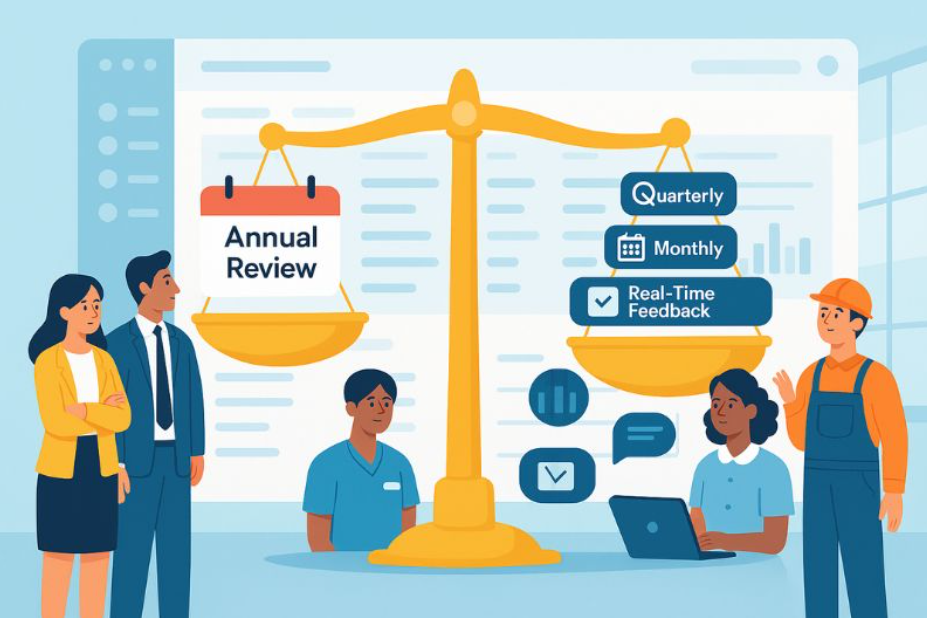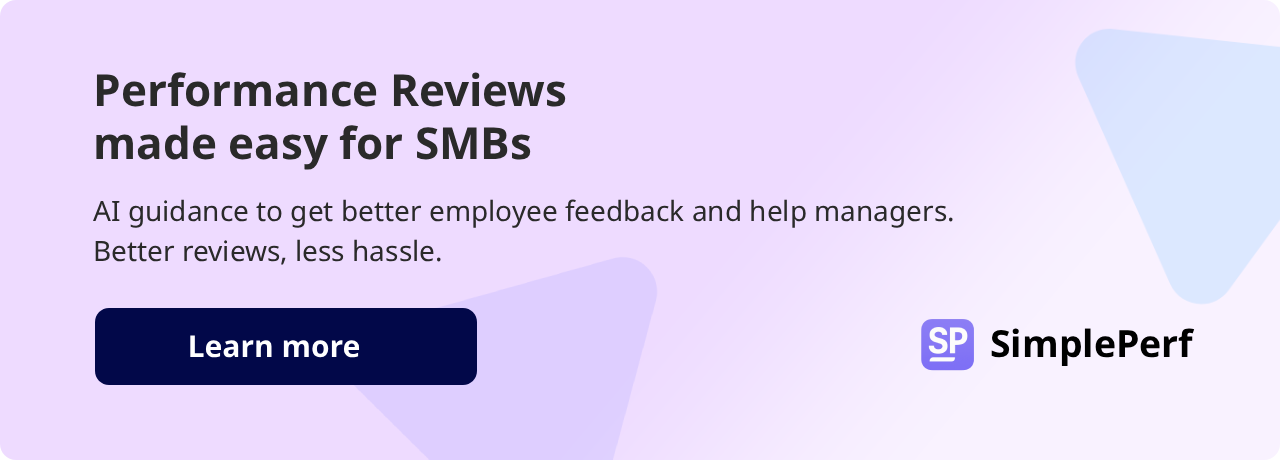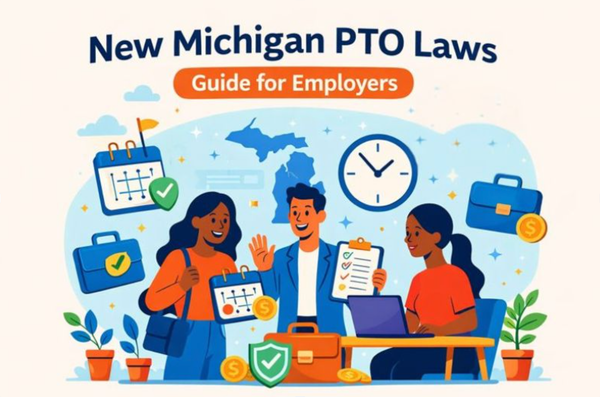Too much or not enough? How often should performance reviews be conducted?
Discover how often to conduct performance reviews, with BuddiesHR and get industry-specific guidelines to improve employee performance and meet company goals.

How often should we do performance reviews? Valid question. There are a number of criteria that affect this answer, but if we break it down into the most important parts, the question is really about what’s required to give enough corrective feedback, without overwhelming employees (and managers) with the review process.

You want to keep employees engaged and focused, while providing timely support and training. You want managers to stay plugged into giving unbiased and valuable insights into the team’s performance.
But what you don’t want is an enforced review cycle that everyone hates, and doesn’t get much value out of. We answer the question: How often should performance review be conducted, with a view to helping you get the right balance for your business.
Key Takeaway: Performance reviews should be conducted frequently enough to drive improvement, but not so often that they become burdensome. The ideal cycle depends on your industry, employee needs, and pace of change. Automating the review process with tools like BuddiesHR can help you strike the perfect balance.
General rule: How often a performance appraisal should be conducted?
For many decades, annual performance reviews were a staple in the U.S. Baby Boomers required structured one-on-one conversations, and manager input for development. However, this looks very different today where Millennials make up the majority of the workforce (predicted to be 75% globally in 2025) [1].
With social media, smartphones, 24/7 emails, remote working locations, and video conferencing widely available, face-to-face annual reviews no longer meet the needs of the global workforce (especially Millennials who are the first globalised generation in history).
The average worker is now hyperconnected, and requires more frequent input from team members and their superior. This is partly due to the rapid pace of change and the need for ongoing skill development. What has fundamentally changed is that the performance review process is no longer just about wage increase discussions, but about the everyday steps needed to run successful careers and businesses. [2]
While a formal performance review may still be conducted annually, quarterly reviews, monthly reviews, and real-time feedback in the form of check-ins are now becoming the new norm.
👉 If you're rethinking your review process for a Millennial-majority or hybrid workforce, then do it with a partner that understands their language. BuddiesHR’s employee engagement apps have been designed for the Slack environment, bringing employee recognition, performance reviews, peer-to-peer engagement, and feedback into a platform that the millennials love. See it in action 🤖
What factors determine how often you should evaluate employee performance?
Setting up a performance management review cycle depends on a number of factors. Considering these factors will help you to tailor your performance review process to the needs of your business.
1. How invested are you in improving employee performance?
Theoretically, every business understands that improving employee performance is key to achieving the desired outputs. Practically, however, there is often much less focus on employee reviews for managing performance. The most enduring reason for this is that managers don’t have the time to invest in regular feedback.
While this might be true, it conveys a mindset that employee development is not as important for meeting organizational goals as pursuing sales, achieving stellar customer service reviews, and delivering high-quality products or services. But examine this mindset for its value. How do you meet these objectives without the buy-in and skills of your people? And how do you improve that commitment without placing importance on two-way feedback?
So what’s the answer? How can you have your pie and eat it, so to speak? The solution lies in automating the administrative tasks that consume time in the review process, and in making the feedback you provide so effective and clear that you don’t have to spend hours every month on it. That’s a tall order, but one that is achievable.
With BuddiesHR, you can automate admin-heavy tasks like scheduling reviews, gathering 360° feedback, and even generating summaries—giving you time back to focus on what matters. Experience it firsthand.
Performance automation as a solution for meeting performance goals through reviews
In summary, automating formal reviews (and informal check-ins) is about using generative AI tools that plug into your performance metrics, gather information in an organic way, draft reviews based on 360-degree evaluations and self-assessment, and identify high- and low- performers based on unbiased metrics.
It’s a powerful union of data collection and insightful feedback that provides the basis for continuous feedback. Furthermore, these generative tools are highly customizable, and that means you can do multiple reviews using different formats that suit the working habits of the X’ers, and Millennials alike (which now covers most of the workforce).
If you’ve never considered performance review automation before, Simpleperf is the ideal starter app for managing your reviews from start to finish.
Need more? Read 👉 AI in Performance Management: Strategic Use, Not Hype
2. How quickly do employees in your industry need to adapt?
This is about how quickly things change in your industry, and how easily your employees are likely to adapt to these changes. Some industries evolve very little over 12 months because processes and skills are highly specialized (and even regulated). In this case, conducting full monthly reviews, quarterly reviews, and an annual review would be excessive (with the exception of new employees).
In an industry or field that demands a high level of agility and growth, quarterly and then annual reviews would fall hopelessly short of the requirements. Therefore, one of the key considerations in planning your review cycle has to be the need for responsive change and adaptation.
3. How far back do you want to hold employees accountable for their performance?
Most workplaces want to be responsive to struggling employees and high-performing employees because it's better and easier to do it that way than create a hit-and-miss approach based on delayed data and performance feedback.
As you consider this, ask yourself: How long does it take for employees to get good at what they’re doing in your business, and how long do you want to take before acting on something that’s not working?
For example, if your business relies on being responsive and you make shifts every 3-6 months, then you should align with this by implementing monthly reviews throughout the year, making check-ins an ongoing process, and tying compensation to an annual review.
By discussing: What is a performance review and how to conduct great ones?, a few key elements emerge that will help you build the perfect review system for your business.
How often should you do a progress review: Industry breakdown
While performance reviews are not regulated, and every company has different needs, we can make some suggestions based on norms and what makes logical sense. For increased employee engagement and meeting company goals, start with these industry-specific recommendations.

✅ Want to tailor your review cycle to your industry and automate the entire workflow?
BuddiesHR lets you configure the performance review process by role, team, or department—with built-in templates, reminders, and analytics. 👉 Start customizing with Simpleperf.
Too much or not enough? The debate has been settled
The frequency of performance reviews is not a ‘one-size-fits-all’ subject. While annual reviews have been the norm for many decades, the changing workforce driven by technology and remote working is requiring a more tailored and responsive approach.
The extent to which you are invested in improving employee performance, the pace at which your industry needs to adapt, and the timeframe for holding employees accountable for their performance are key factors in determining how to structure your review cycle.
Responding to the changing workforce, globalization, and technological and regulatory advances may require industry-specific review cycles rather than the highly formal, face-to-face review of days past. You need to do what works for the future, and with BuddiesHR, you can quickly adapt performance review cycles to meet the demands of your workforce and business objectives. Problem solved!
Further reading: How to prepare for a performance review as a manager: Beginner’s Guide

References:




